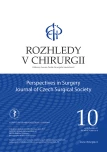Intraperitoneal onlay mesh – an analysis of the patient‘s cohort
Authors:
L. Kohoutek; P. Plecháčová; R. Roxer; J. Musil; B. Karkošková
Authors‘ workplace:
Chirurgické oddělení Nemocnice Frýdlant, s. r. o., EUC, a. s.
Published in:
Rozhl. Chir., 2018, roč. 97, č. 10, s. 459-463.
Category:
Original articles
Overview
Introduction:
Incisional hernias represent one of the most complex and widely discussed issues of abdominal wall surgery. 10–20% of the cases occur following abdominal surgery. The aim of this study is to describe our surgical experience and determine whether the intraperitoneal onlay mesh (IPOM) procedure is suitable for hernia surgery with minimal postoperative complications.
Method:
The paper focuses on patients operated on by the IPOM technique between 2015 and 2016. The group involved 53 patients with median or paramedian defects after acute or elective abdominal surgery. In patients with comorbidities, thorough preoperative examination was completed including abdominal ultrasound, colonoscopy and spirometry. In the postoperative period, we evaluated pain using the visual analogue scale, wound healing, relapses and patient´s satisfaction with functional as well as aesthetic outcomes of the surgery.
Results:
Our group comprised 53 patients operated on using the IPOM technique. They were 48−79 years old with a body mass index exceeding 30 kg/m2. 18 patients had a paramedian hernia and 35 patients median hernia. 4 patients suffered a perioperative iatrogenic injury of the intestine, 8 cases developed postoperative paralytic ileus. Wound infection or infection of the mesh was not recorded. 2 patients with hernia recurrence were followed up for one year.
Conclusions:
Incisional hernias represent an important surgical issue. Management is often complex. IPOM as the treatment of choice for patients with incisional hernias appears to be beneficial. However, it requires careful patient selection, patient preparation for surgery and their compliance, the surgeon’s extensive experience as well as excellent postoperative care with limited postoperative pain. The success rate of this method is high in carefully selected patients.
Key words:
IPOM – incisional hernia – patient compliance
Sources
- Hernias, a few statistics. 2017. Available from: www.herniamed.de/?q=en/node431.
- Bittner R, Bingener-Casey J, Dietz U, et al. Guidelines for laparoscopic treatment of ventral and incisional abdominal wall hernias (International Endohernia Society (IEHS) - part 1. Surg Endosc 2014;28:2−29.
- Burger JWA, Halm JA, Wijsmuller, AR, et al. Evaluation of new prosthetic meshes for ventral hernia repair. Surg Endosc 2006. Available from: doi:10.1007/s00464-005-0706-4.
- Silecchia G, Campanile FC, Sanchez L, et al. Laparoscopic ventral/incisional hernia repair: updated guidelines from the EAES and EHS endorsed Consensus Development Conference. Surg Endosc 2015. Available from: doi:10.1007/s00464-015-4293-8.
- Froylich D, Segal M, Weinstein A, et al. Laparoscopic versus open ventral hernia repair in obese patients: a long-term follow-up. Surg Endosc 2016. Available from: doi:10.1007/s00464-015-4258-y.
- Nardi M, Millo P, Contul RB, et al. Laparoscopic ventral hernia repair with composite mesh: Analysis of risk factors for recurrence in 185 patients with 5 years follow-up. Int Surg 2017;40:38−44.
- Davies CS, Ismail A. Nicotine has deleterious effects on wound healing through increased vasoconstriction. BMJ 2016. Available from: doi: 10.1136/bmj.i2709.
- Ryska M., Bauer J. Kolorektální karcinom – význam lokalizace primárního nádoru. Rozhl Chir 2017;96:4−8.
- Zdravotnictví ČR: Nová data Národního onkologického registru (NOR) za rok 2014. 2015. Available from: www: http://www.uzis.cz/publikace/zdravotnictvi-cr-nova-data-narodniho-onkologickeho-registru-cr-nor-za-rok-2014.
- Cavalli M, Biondi A, Bruni PG, et al. Giant inguinal hernia: the challenging hug technique. Hernia 2015;19:775.
- Muysoms FE, Miserez M, Berrevoet F. et al. Classification of primary and incisional abdominal wall hernia. Hernia 2009; 13:407−4.
- Yang GPC. From intraperitoneal onlay mesh repair to preperitoneal onlay mesh repair. Asian J Endosc Surg 2017;10:119−27.
- LeBlanc KA. Laparoscopic incisional hernia repair: are transfascial sutures necessary? A review of the literature. Surg Endosc 2007;21:508−13.
- Rogmark P, Ekberg A, Montgomery A. Long-term retromuscular and intraperitoneal mesh size changes within a randomized controlled trial on incisional hernia repair, including a review of the literature. Hernia 2017;21:687–96.
Labels
Surgery Orthopaedics Trauma surgeryArticle was published in
Perspectives in Surgery

2018 Issue 10
Most read in this issue
- Spontaneous bilateral rupture of patellar ligament
- Current possibilities of dural reconstruction in neurosurgery
- Intraperitoneal onlay mesh – an analysis of the patient‘s cohort
- Concomitant embolism in the subclavian and pulmonary artery
